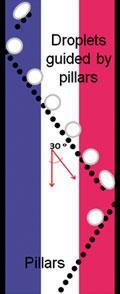A device set up like a pinball machine guides oil droplets through polymers to build up polymer layers
A device to deposit polymer layers on oil droplets has been made by researchers from Singapore, who say that their design is faster and more efficient than conventional deposition techniques and it achieves the highest number of polymer layers reported so far using microfluidics. The device could be used to encapsulate drugs for delivery or be used to create capsules for biosensing.

Dieter Trau from the National University of Singapore and colleagues have used a method that they call ’microfluidic pinball’ to guide oil droplets through channels created by rows of micropillars, like a pinball machine. The rows are orientated in a zigzag fashion across three liquid streams - two polymers and a washing station. The angles created by the rows, as well as the flow rates in the streams, determine how long droplets stay in each channel.
The droplets are guided along the rows to travel repeatedly through the three streams. The team found that six polyelectrolyte layers could be deposited on a droplet in under three minutes - they were able to see the layers with fluorescence spectroscopy. Atomic force microscopy revealed the thickness of each layer to be approximately 2.8nm.
The device is simpler than many other microfluidic devices because the interface with input mechanisms is simpler, explains Trau. He goes on to highlight that another benefit of the device ’is that it does not require electrical signals to manipulate droplets and it can be fabricated in polydimethylsiloxane, a cheap and easy-to-use polymer.’
’The method gives highly original access to coated colloids and capsules using microfluidics,’ says Helmuth M?hwald from the Max Planck Institute of Colloids and Interfaces in Potsdam, Germany. ’It will enable a continuous process with minimal waste.’ He goes on to say that ’they will need to take major steps in the future to arrive at quantities sufficient for applications. Still, the approach is promising, at least for high throughput screening applications.’
Trau and his team hope to focus on encapsulating lipophilic drugs - drugs that dissolve more easily in oils than in water - using the microfluidic pinball approach.
Jennifer Newton
Link to journal article


for on-chip generation of Layer-by-Layer polyelectrolyte microcapsules
Chaitanya Kantak, Sebastian Beyer, Levent Yobas, Tushar Bansal and Dieter Trau,?
Lab Chip
, 2011,
11
, 1030






No comments yet